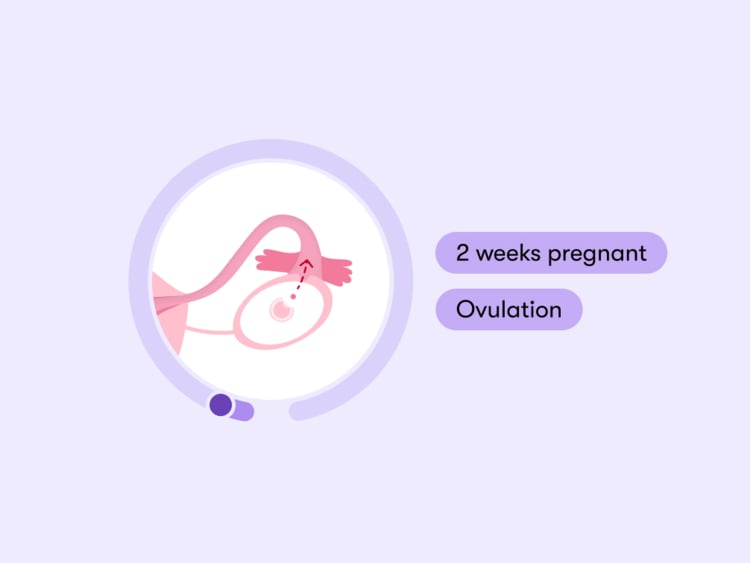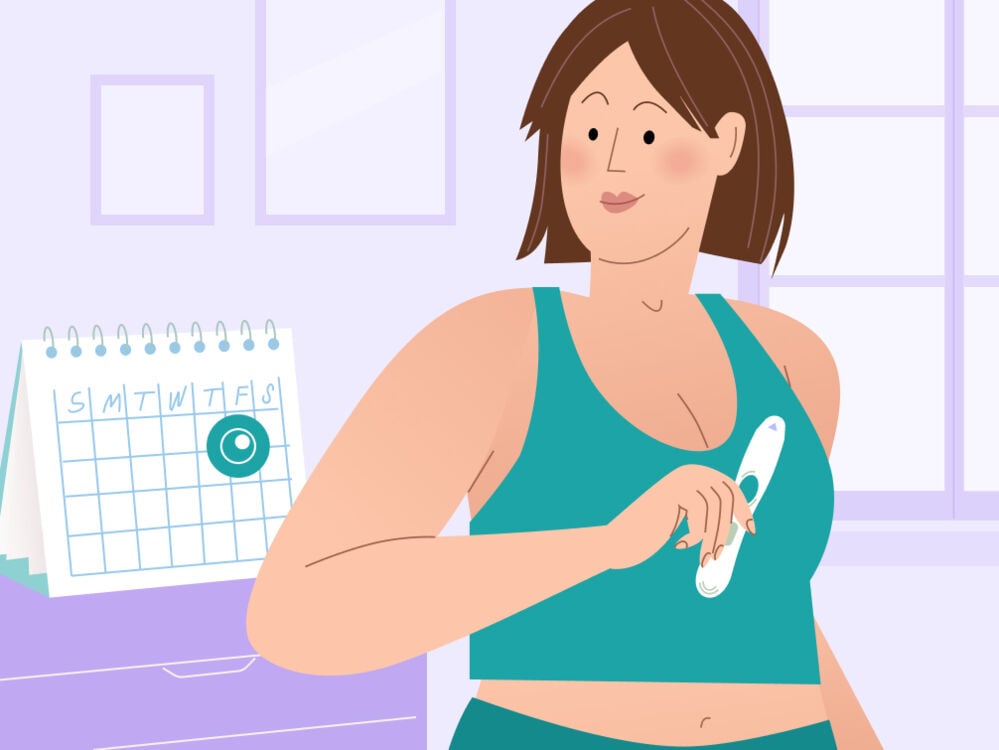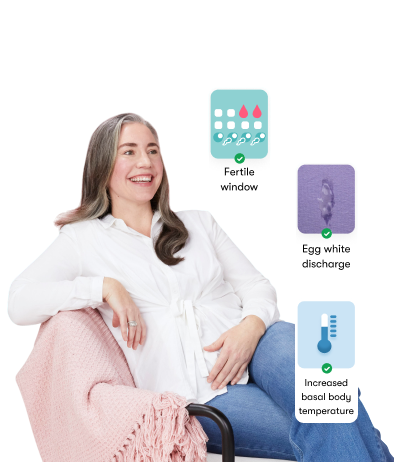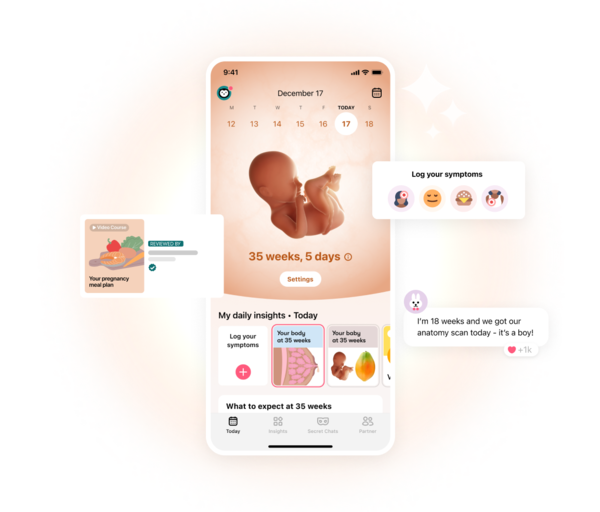From noticing ovulation symptoms to having lots of sex, here’s the lowdown on being 2 weeks pregnant.
-
Tracking cycle
-
Getting pregnant
-
Pregnancy
-
Help Center
-
Flo for Partners
-
Anonymous Mode
-
Flo app reviews
-
Flo Premium New
-
Secret Chats New
-
Symptom Checker New
-
Your cycle
-
Health 360°
-
Getting pregnant
-
Pregnancy
-
Being a mom
-
LGBTQ+
-
Quizzes
-
Ovulation calculator
-
hCG calculator
-
Pregnancy test calculator
-
Menstrual cycle calculator
-
Period calculator
-
Implantation calculator
-
Pregnancy weeks to months calculator
-
Pregnancy due date calculator
-
IVF and FET due date calculator
-
Due date calculator by ultrasound
-
Medical Affairs
-
Science & Research
-
Pass It On Project New
-
Privacy Portal
-
Press Center
-
Flo Accuracy
-
Careers
-
Contact Us
2 weeks pregnant: Your guide to this week of your first trimester


Every piece of content at Flo Health adheres to the highest editorial standards for language, style, and medical accuracy. To learn what we do to deliver the best health and lifestyle insights to you, check out our content review principles.
Wondering if you might be pregnant can sometimes feel scary and overwhelming, even if you’re hoping for a positive result. But knowledge is power, and knowing the signs and symptoms of early pregnancy can help you feel more prepared and in tune with your body. That’s why we’ve created this week-by-week guide with insights from a Flo expert.
Read on to find out if you can feel any symptoms at 2 weeks pregnant, how pregnancy is calculated, plus what’s likely to be happening in your body at 2 weeks pregnant.
Your pregnancy at 2 weeks
The weeks of your pregnancy are counted from the first day of your last period. So as weird as it sounds, at 2 weeks, you aren’t actually pregnant yet. In fact, you would only be considered 2 weeks pregnant in hindsight. Confused? Let’s do a quick biology lesson. Medically speaking, the gestational age (or the “age” of your pregnancy) is different from the fetal age (or the “age” of your baby). Gestational age is calculated from the start of your last period, while fetal age is calculated from the time of fertilization. You can learn more about gestational age in our handy guide or you can use our pregnancy calculator to help determine how far along you are.
This might seem strange and confusing at first, but if you do conceive, counting the weeks like this will make more sense as your pregnancy progresses. Dr. Jenna Flanagan, academic generalist obstetrician and gynecologist, Beth Israel Deaconess Medical Center, Massachusetts, US, explains why gestational age is calculated this way: “Due to the fact that the fertility window spans approximately 7 days, dating the pregnancy by when ovulation [the release of an egg] occurred is inherently inaccurate,” she explains. “Many people do not know when ovulation occurs or the exact day fertilization or implantation occurs. However, the first day of the last menstrual period is often a day people track whether they are trying to conceive or not.”
So, to recap, 1 week pregnant is the start of your new cycle. 2 weeks is the start of ovulation and your body releasing an egg, ahead of a potential fertilization of that egg by a sperm. Once a fertilized egg has implanted into your uterus, then you are officially pregnant — usually between 6 and 10 days after ovulation.

Your body at 2 weeks pregnant
It’s too early for pregnancy symptoms
As you’re not technically pregnant yet, it’s still too early for any pregnancy symptoms. However, there’s still a lot going on — as you’ll see in detail below, your body may just be preparing for ovulation this week.
So you know what to look out for in a couple of weeks’ time, some very early pregnancy signs include things like a missed period, fatigue, and breast tenderness. It’s worth noting that it can be tricky to differentiate between PMS versus pregnancy symptoms, as many of them overlap (thanks, Mother Nature!). So, for example, your breasts might start to feel sore because you’re about to start your period, or they could be hurting because you’re pregnant. Remember, it’s natural if you’re struggling with the uncertainty of it all — many women do. Try to hang in there and know that it won’t be long before you can finally take a pregnancy test.
Ovulation symptoms
2 weeks pregnant is often the time when ovulation takes place, making this an important stage of your path to conception. Ovulation is when one of your ovaries (either your left or your right) releases an egg into your fallopian tube (again, either your left or your right), ready to be fertilized by a sperm.
As ovulation is so important for conception, let’s take a closer look at what it involves. Since the start of your cycle, your body will have been producing increasing levels of the follicle-stimulating hormone (FSH) to cause the follicles inside your ovaries to mature. Meanwhile, rising levels of luteinizing hormone (LH) trigger an ovary to release an egg (ovulation). As this happens, the follicle containing the egg is ruptured. In an average 28-day cycle, this usually happens around day 14.
These hormonal changes can result in a number of ovulation symptoms. For example, you may notice your cervical mucus becoming more slippery, wet, and stretchy, a bit like egg whites — a symptom that some women track to know when they’re most fertile.
Other symptoms of ovulation that you may notice include:
- A heightened sense of smell
- Breast soreness or tenderness
- Pelvic or abdominal pain
- Light spotting or discharge
- Libido changes
- Changes in the position and firmness of your cervix, which you can only feel by inserting your finger into your vagina
Having said all of that, you might not notice any symptoms of ovulation at all. “Most commonly, people don’t actually feel ovulation when it occurs,” explains Dr. Flanagan. So if you aren’t getting any obvious signs of ovulation, don’t panic. This is a common experience, and you’ll find various at-home ovulation tests at your drug store to help you know when it’s happening. You can also read our guide to learn how to choose the right ovulation test for you.
Another way to track ovulation is by measuring your daily basal body temperature (BBT), i.e., your resting temperature. Once ovulation has happened, your temperature should increase very slightly. You may also notice your temperature dip slightly before ovulation. It can take a few cycles before you see a pattern emerge, so you’d ideally want to start tracking this a few months before you start trying to conceive.
Note that BBT tracking may be tricky, given that body temperature can also be affected by factors like sleep, alcohol use, or even a fever. Of course, you can also use an app like Flo to help you figure out when you’re ovulating, or try out our handy ovulation calculator.
Take a quiz
Find out what you can do with our Health Assistant
Your questions answered
Does your belly hurt when you’re 2 weeks pregnant?
Although you won’t get any pregnancy symptoms at this stage, you might experience symptoms of ovulation. As mentioned previously, pelvic or abdominal pain can indeed be a common symptom of ovulation. So it is possible for your stomach to hurt when you’re 2 weeks pregnant, but not because there’s a baby there just yet.
In fact, up to 40% of women experience pain during ovulation, which can feel like cramps, pressure, or stronger pain in your lower abdomen.
“Some people report twinges or discomfort on one side or the other of their lower pelvis during the 1–2 days when ovulation is occurring,” says Dr. Flanagan. This is referred to as “Mittelschmerz,” which is German for “middle pain,” referring to ovulatory pain that happens in the midcycle.”
She continues: “If pain is experienced, it tends to be short-lived and described as in the pelvic area, usually on the side where ovulation is occurring.”
The exact cause of ovulation pain is unknown. However, possible reasons include follicle growth stretching the surface of your ovary or blood or fluid released from the ruptured follicle irritating the lining of your stomach.
Can you tell if you’re pregnant at 2 weeks?
Not just yet — at 2 weeks, you’re not technically pregnant. You’re only considered 2 weeks pregnant in hindsight, after implantation has occurred. But as we’ve seen, there’s still a lot going on in your body to prepare for a potential pregnancy to occur.
Should I take a pregnancy test?
As you’re not technically pregnant yet, it’s still too soon to take a pregnancy test. The best time to take a pregnancy test is anytime starting from the first day of a missed period. While it can be frustrating to wait, this will help you to get the most accurate result. This is because at-home pregnancy tests detect human chorionic gonadotrophin, which your body only starts to produce around 6 days after fertilization.
If your cycle is regular, your missed period may happen at around 4 weeks of pregnancy. For those with irregular cycles, experts recommend you take the test at least 21 days after unprotected sex. But if you need more guidance, don’t hesitate to ask your doctor for their advice.
When you’re trying for a baby, waiting to take a test can feel incredibly long. It can help to try and focus your mind on something else, but we know this can be much easier said than done!
2 weeks pregnant checklist
Great news: If you’re trying to conceive, this week could be a good time to have lots of sex. Your fertile window includes the 5 days leading up to ovulation plus the day of ovulation and the day after that. Starting from 2–3 days after your period, having sex every 2–3 days helps to make sure you are having sex when you are most fertile.
“Having intercourse every day or every other day is sufficient to expose the egg to sperm for fertilization,” Dr. Flanagan explains. “Sperm can live in your body for three to five days; therefore, having intercourse at least every three days during the fertile window can ensure the proper amount of sperm exposure for the egg when it is released.”
If you have irregular periods, then calculating your fertile window can become a bit more difficult. But don’t worry; it’s still possible to conceive! If you’re trying to get pregnant, having sex every 2–3 days consistently throughout your cycle can help.
When to consult a doctor
You don’t need to contact your doctor about a pregnancy until you’ve had a positive pregnancy test. However, do get in touch with your health care provider if you have irregular periods or any other concerns about conceiving.
2 weeks pregnant: The takeaway
This week, with ovulation just around the corner, you might be at your most fertile. Try not to worry if you haven’t felt any ovulation symptoms, as it’s common not to notice them. And remember, if you’re trying to conceive, now is the time to have lots (and lots!) of sex.


Hey, I'm Anique
I started using Flo app to track my period and ovulation because we wanted to have a baby.


The Flo app helped me learn about my body and spot ovulation signs during our conception journey.


I vividly
remember the day
that we switched
Flo into
Pregnancy Mode — it was
such a special
moment.
Real stories, real results
Learn how the Flo app became an amazing cheerleader for us on our conception journey.
References
“Am I Pregnant?” Cleveland Clinic, my.clevelandclinic.org/health/articles/9709-pregnancy-am-i-pregnant. Accessed 24 May 2023.
“Basal Body Temperature.” Cleveland Clinic, my.clevelandclinic.org/health/treatments/21065-basal-body-temperature. Accessed 24 May 2023.
“Basal Body Temperature for Natural Family Planning.” Mayo Clinic, 10 Feb. 2023, www.mayoclinic.org/tests-procedures/basal-body-temperature/about/pac-20393026.
Brott, Nathan R., and Jacqueline K. Le. “Mittelschmerz.” StatPearls, StatPearls Publishing, 2022.
“Cervical Mucus.” Cleveland Clinic, my.clevelandclinic.org/health/body/21957-cervical-mucus. Accessed 24 May 2023.
“Cervix.” Cleveland Clinic, my.clevelandclinic.org/health/body/23279-cervix. Accessed 24 May 2023.
“Doing a Pregnancy Test.” NHS, www.nhs.uk/pregnancy/trying-for-a-baby/doing-a-pregnancy-test/. Accessed 24 May 2023.
“Fertility Awareness-Based Methods of Family Planning.” The American College of Obstetricians and Gynecologists, Jan. 2019, www.acog.org/womens-health/faqs/fertility-awareness-based-methods-of-family-planning.
“Fetal Development.” Perinatology, perinatology.com/Reference/Fetal%20development.htm. Accessed 24 May 2023.
“Follicle-Stimulating Hormone (FSH).” Cleveland Clinic, my.clevelandclinic.org/health/articles/24638-follicle-stimulating-hormone-fsh. Accessed 24 May 2023.
“Follicle-Stimulating Hormone (FSH) Levels Test.” MedlinePlus, medlineplus.gov/lab-tests/follicle-stimulating-hormone-fsh-levels-test/. Accessed 24 May 2023.
“How to Get Pregnant.” Mayo Clinic, 11 Dec. 2021, www.mayoclinic.org/healthy-lifestyle/getting-pregnant/in-depth/how-to-get-pregnant/art-20047611.
“Luteinizing Hormone (LH) Levels Test.” MedlinePlus, medlineplus.gov/lab-tests/luteinizing-hormone-lh-levels-test/. Accessed 24 May 2023.
Menstrual Cycle: Animation. NHS, www.nhs.uk/conditions/irregular-periods/.
“Mittelschmerz.” Mayo Clinic, 17 Dec. 2022, www.mayoclinic.org/diseases-conditions/mittelschmerz/symptoms-causes/syc-20375122.
“Ovulation.” Cleveland Clinic, my.clevelandclinic.org/health/articles/23439-ovulation. Accessed 24 May 2023.
“Ovulation Detection.” Reproductive Facts, www.reproductivefacts.org/news-and-publications/patient-fact-sheets-and-booklets/documents/fact-sheets-and-info-booklets/ovulation-detection/. Accessed 24 May 2023.
“Ovulation Signs: When Is Conception Most Likely?” Mayo Clinic, 7 Dec. 2022, www.mayoclinic.org/healthy-lifestyle/getting-pregnant/expert-answers/ovulation-signs/faq-20058000.
Su, Ren-Wei, and Asgerally T. Fazleabas. “Implantation and Establishment of Pregnancy in Human and Nonhuman Primates.” Advances in Anatomy, Embryology, and Cell Biology, vol. 216, 2015, pp. 189–213.
“You and Your Pregnancy at 1 to 3 Weeks.” NHS, www.nhs.uk/pregnancy/week-by-week/1-to-12/1-2-3-weeks/. Accessed 24 May 2023.
“Your NHS Pregnancy Journey.” NHS, www.nhs.uk/pregnancy/finding-out/your-nhs-pregnancy-journey/. Accessed 24 May 2023.
History of updates
Current version (28 June 2023)
Published (24 February 2019)
In this article

Get your personal guide to pregnancy with the Flo app
-
Follow your baby's growth week by week
-
Get expert info on symptoms, safe foods, and more
-
Chat with other parents-to-be




